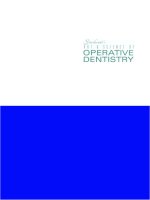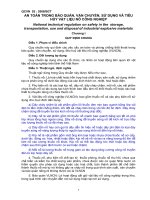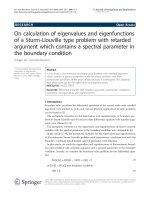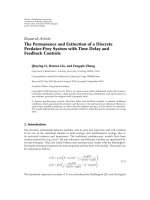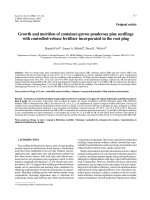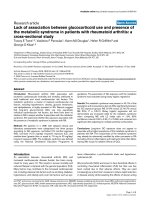1997 the use and training of the human voice 3rd edition (WITH BOOKMARKS)
Bạn đang xem bản rút gọn của tài liệu. Xem và tải ngay bản đầy đủ của tài liệu tại đây (12.11 MB, 312 trang )
THE
USE
OF THE
AND
TRAINING
HUMAN
VOICE
ARTHUR LESSAC
The Use and
Training
of the
Human Voice
A BIO-DYNAMIC
APPROACH
TO
VOCAL
THIRD
LIFE
EDITION
Foreword by
Frank Langella
Boston Burr Ridge, IL Dubuque, lA Madison, WI New York
San Francisco St. Louis Bangkok Bogota Caracas Kuala Lumpur
Lisbon London Madrid Mexico City Milan Montreal New Delhi
Santiago Seoul Singapore Sydney Taipei Toronto
Also by Arthur Lessac
Body Wisdom: The Use and Training of the Human Body
McGraw-Hill Higher Education
t/2
A Division of The McGraw-Hill Companies
THE USE AND TRAINING OF THE HUMAN VOICE,
THIRD EDITION
Copyright ©1997, 1967, 1960 by Arthur Lessac
No part of this publication may be reproduced or distributed
in any form or by any means, or stored in a database or
retrieval system, without the prior written consent to The
McGraw-Hill Companies, Inc., including, but not limited to, in
any network or other electronic storage or transmission, or
broadcast for distance learning.
7 8 9 0 VBAIVBA 0 9 8 7 6 5 4 3
ISBN 1-55934-696-5
Library of Congress Cataloging-in-Publication Data
Lessac, Arthur.
The use and training of the human voice : a bio-dynamic
approach to vocal life I Arthur Lessac ; foreword by Frank
Langella.-3rd ed.
p.
em.
Includes index.
ISBN 1-55934-696-5
1. Voice culture. I. Title.
PN4162.L46 1996
808.5-dc20
96-18629
CIP
Sponsoring editor, Janet M. Beatty; production editor, Melissa
Kreischer; manuscript editor, Andrea McCarrick; design
manager, Susan Breitbard; art editor, Bettina Borer; text and
cover designer, Joan Greenfield; manufacturing manager, Amy
Folden. This text was set in 10/12.5 New Aster by Wilsted &
Taylor and printed on 50# Text White Opaque by Maple-Vail
Book Manufacturing Group.
www.mhhe.com
Foreword
Sometimes all at once ... there's God." So said Tennessee Williams in one
of his plays. Arthur Lessac is not quite God to me, but he's certainly a piece
of heaven.
I can remember quite clearly the day I grasped his technique for the
first time, or should I say, the day I felt it for the first time. I was standing
amidst a group of some thirty students. I was twenty-four years old, new to
New York, and a member of the Lincoln Center Training Programeight hours a day of Body, Voice and Acting classes to prepare us as members of the first acting troupe for the then-as-yet-unbuilt Vivian Beaumont Theatre.
Arthur was leading us in a vocal exercise using the words: HelloAway-Until. He was trying to make us understand where to place these
sounds and how to project them. I wasn't getting it. My throat was closed
and my eyes were tearing. I would cough, tighten up, and lose my breath.
All around me were young actors with similar difficulties.
Like any other training approach, until a certain "body truth" happens, it can seem somewhat strange. You're asking your body to reprogram its computer and at first it rebels. Mine certainly did. I had, up
until Arthur Lessac, done okay with my voice, I thought. But I had not as
yet really tested it on the great roles, or in extended long runs, or in cavernous old theatres. Nor had I yet come to respect its power.
But this day, as Arthur walked among us loosening cheeks, directing
mouths forward, correcting breathing and posture, my body decided to
accept his lessons. I felt in my upper palate a tingle as if the words were
born in my mouth. My breath eased, and out came a sound I had never before made. The feeling was immediate and profound. My body said, "Yes."
Arthur heard it and said, "Yes, Frank, yes." "God" spoke, and from that moment on I was free. The way you are free when you finally learn to swing a
bat, or play a scale, or when you effortlessly pull up on your skis for the first
time. You may fall down from time to time, but you've got it forever.
vi
Foreword
I got the Arthur Lessac process and for thirty years or more it has sustained me. I have never lost my voice due to strain, overuse, or, more importantly, misuse. I have been able to project it in any auditorium. It has
given me infinite vocal freedom. It works, and once acquired it will do the
same for you.
Perhaps more importantly, his methodology is real therapy for voice
and body. The more you do it, the better you feel. It's a boon to anyone:
actor, public speaker, singer, vocally impaired, private citizen. Once
learned it never deserts you. It's simple to maintain and only strengthens
the voice as you grow older. It's always there, even if all you do is call your
dog from across the road.
I am extremely grateful that fate put me into Arthur's hands at so
young an age. Like all great teachers, he gives you the tools to allow you to
run free. If you suffer through body resistance, vocal distress, and mental
strain, and conquer them through the Lessac training, you'll be out in
front, in the lead, at full gallop and feeling great.
-Frank Langella
July 8, 1996
Acknowledgments
This newly revised edition of The Use and Training of the Human Voice reflects over forty good years of teaching, training, performing, and research, during which time I've been the fortunate beneficiary of the most
stimulating encouragement, guidance, healthy criticism and support
from my many friends, colleagues, associates and students. I take this opportunity to single out, for very special thanks and appreciation, Walter
Lowen, David Simon, David Morgan, Al Brooks, Irene Dailey, Sue Ann
Park, Bonnie Raphael, Bob Hobbs, Jack Clay, Cissie Blumberg, Mary
Corrigan, Lisbeth Roman, Richard and Saundra Cuyler, Dorothy Mennen,
Richard Warner, John Reich, Bob Lear, Don Wilson, Tom Leabhart,
Norma Berkeley, and, most of all, Michael Lessac.
Additionally, I want to express my gratitude to others who have also devotedly helped and contributed to the task of preparing, for this revision,
four generations of manuscripts over the past three years. They include
Debbie Kinghorn, Kathy Dunn, Nancy Krebs, Mary Thomas, Kathleen
Campbell, Marth Munro, Tom Casciero, Sheila Sabrey-Saperstein, Ann
Marie Jodoin, Georgia Martin, Andy Griggs, Ruth McKenney, Beth
McGee, Jennifer Schuler, Sandra Shotwell, Barry Kur, Kate Burke,
Colleen Kelly, Patricia Romanov, Kittie Verdolini, Carol Prendergrast,
Leonard Meenach, Diane Gaary, Yanci Bukavec, and Fred Nelson.
There have also been professional colleagues who have reviewed later
drafts of the manuscript, whose names I don't have the privilege of knowing, but whose input and critiques have been invaluable to me. There must
be others whose names I may have inadvertently omitted here, and I want
to thank all of them most heartily as well.
And finally, a most enthusiastic thank you to my Mayfield team of
editors, led by Janet Beatty, sponsoring editor, and Melissa Kreischer, production editor, who worked valiantly to bring this project to a successful
conclusion; and a special bow to Bettina Borer, art editor, and to my talented and dedicated manuscript editor, Andrea McCarrick.
Introduction
The subject of this book is vocal life. Although it is a resource for anyone
who wants a beautiful voice and who requires clear, articulate speech, I
address this revised edition primarily to teachers and students of acting
at colleges, universities, and private studios and to professional actors
working in theatre, film, and television. Regardless of what level you have
reached in your teaching or acting careers, you will, I hope, find the process laid out here immediately accessible, applicable, and empowering.
It will describe goals you can relate to and ways to reach them. Through
your own searching, discovering, and doing, you will fully understand the
feeling of complete mastery of voice and speech and its relatedness to the
quality of performance. This book is about finding your own voice, rediscovering your own originality, reexploring your artistic skills and talents,
and reinforcing and expanding your communicating personality. Terms
that may be unfamiliar are defined in the text, footnotes, and glossary.
Hopefully, you will find that Lessac training is not a rigid step-by-step
progression. The new order of this book reflects a circular sequence that
has worked extremely well and with maximum flexibility in studios and in
workshops. Feel free to adapt and experiment along the way. Wander
through the chapters at will, but with curiosity and awareness. You will
find the book's principles, experiments, and explorations part of an innate, vital whole, and, as such, you may enter the training at any point as
a viable starting place. Because of its natural circuitry, Lessac training
employs a dynamic rhythm and balance to lead you progressively through
the training circle with all the other parts always connected, always in
motion.
Whatever else you gain from this book, I hope you will find yourself
exploring the idea that nothing stands alone, isolated, or encapsulatednot your voice, your speech, your body, or any of the modalities through
which you perceive, feel, emote, or physicalize expression. Everything,
whether simple or radical, is a unique part of something else, for nothing
x
Introduction
functions well enough until it functions in balanced relationship with
everything else. As you use this book, I hope you will sense that we are
building a "whole" out of smaller "wholes"-a "gestalt" out of smaller
"gestalts."
Contents
Foreword by Frank Langella
v
Acknowledgments vii
Introduction
PART
ix
ONE
Seeding the Soil and Building the Foundation
1
Theatre as a Laboratory
Body Esthetics 4
Inner Harmonic Sensing
Organic Instruction 5
The Familiar Event 6
2
3
5
Don't Envy a Good Voice . .. You Have One!
Saying Goodbye to Imitation 10
How Vocal Sound Is Created 11
Resonance and Wave Reflections 13
Anatomy of Voice Production 14
CONTROLLABLE AND NONCONTROLLABLE
FACTORS
15
OVERRIDING THE OUTER EAR
Some Guidelines for Vocal Training
3
1
17
19
The Duality of Breathing and Posture
The Mechanics of Breathing
Behavior-Affective Breathing
21
24
20
9
xii
Contents
Breath and Sound 32
Natural Breathing Experiments
BRIDGE
4
33
44
The Energy of Relaxation:
The Creative Art ofResting
46
The Dynamics of Relaxation 46
Restful Energy and Energetic Rest 47
Control and Consciousness 48
Natural Means of Relaxation: Relaxer-Energizers
so
50
FACIAL- V 0 CAL YAWNING
MUSCLE YAWNING (BENEVOLENT STRETCHING)
M USC L E F L 0 AT IN G
MUSCLE SHAKING
SWALLOWING
52
53
54
Tension-Relieving Experiments
BRIDGE
PART
54
58
TWO
Organically Cultivating the Body's
Vocal NRC States 61
5
The Dynamics of Consonant NRC:
The Music of the Consonants 63
Euphony through Body Esthetics Starting
with the "Child within You" 63
Playing the Consonants 68
The Consonant Orchestra 69
HOW TO EXPLORE THE
CONSONANTINSTRUMENTS
THEN VIOLIN
75
THEM VIOLA
76
THE V CELLO
77
THE F SOUND EFFECT
T H E Z B AS S F I D D L E
78
79
THE S SOUND EFFECT
81
THE B TYMPANI DRUMBEAT
THE P BASS DRUMBEAT
TI-ll='
n
82
83
TVMP4MT nDTTMRPdT
l!Ll
n
51
Contents
THE T SNARE DRUM DRUMBEAT
THE G TYMPANI DRUMBEAT
87
THE K TOM-TOM DRUMBEAT
88
DOUBLE DRUMBEATS
THE TH CLARINET
89
91
THE TH SOUND EFFECT
THE ZH BASSOON
92
93
THE SH SOUND EFFECT
THE L SAXOPHONE
THE NG OBOE
86
94
95
97
THE DG (DZH) CHINESE CYMBAL
THE CH CRASH CYMBAL
THE DZ TAMBOURINE
100
101
THE TS HIGH-HAT CYMBAL
THE H SOUND EFFECT
THE R TROMBONE
102
104
105
THE D•L AND T•L WOODBLOCKS
THEW FLUTE
99
107
110
THE Y FRENCH HORN
111
Linking: Consonant NRG in Connected Speech
Exploring Consonant NRG 119
BRIDGE
120
FEATURING THE Y FRENCH HORN
6
113
The Dynamics of Tonal NRC:
The Music of the Voice Itself 122
Tonal NRG and theY-Buzz and + Y-Buzz
THE RESONATING AREA
121
122
124
DEVELOPING THEY-BUZZ
126
DEVELOPING THE PLUS Y-BUZZ (+Y-BUZZ)
Y-BUZZ AND +Y-BUZZ CARRYOVER
0 PP OR TU NIT I ES
Tonal NRG and the Call
133
136
THE ORIGIN OF THE CALL
137
THE CONTROL OF THE CALL
139
DEVELOPING THE CALL AND THE MAGIC
OF THE YAWN
141
THE PITCH OF THE CALL
143
131
xiii
xiv
Contents
The Dynamics of Structural NRG:
The Music of the Vowels 160
7
The Structural NRG Discovery 161
The Structural Vowels 164
Exploring Structural NRG 168
Exploring Tonal NRG and Structural NRG Combined
Exploring with all Three Vocal NRG Skills 181
BRIDGE
176
183
The Four Neutrals: The Musical Feel of
Staccato and Syncopation in Speech 184
8
Classifying the Four Neutrals
184
188
NEUTRAL VOWELS IN FAMILIAR FORMS
UNSTRESSED }{-DERIVATIVE ENDINGS
188
Cultivating the Four Neutrals 190
The Neutral Diphthongs 192
A Summary of the Tonal, Structural,
and Neutral Vowels 196
BRIDGE
PART
199
3
Reaping What We Sow
9
201
Exploring Creative Vocal Life:
General Exploring and Discovering
203
Discovering Your Inner Environment 204
Short Selections for General Exploration 206
Discovering Your Unique Interpretation and Artistry
Additional Selections for General Exploration 210
BRIDGE
10
214
Exploring Creative Vocal Life:
Specific Exploring and Discovering
215
Enhancing Your Newfound Skills and Creativity in the
Advanced Exploration Process 215
Searching for Opposites 223
Uncovering the Subtext 223
Don't Listen to Yourself-Don't Intellectualize! 224
208
Contents
Suggested Selections for Specific Exploration 225
Suggested Scene for Specific Exploration 238
BRIDGE
11
239
Exploiting Your Creative Vocal Life Onstage
240
The Offstage Voice Onstage 240
ONSTAGE CONVERSATION ACROSS VARYING
DISTANCES
242
The Open Stage 243
Crying and Laughing 245
Screaming and Shouting 245
Warm-up Suggestions 246
B 0 D Y T U N E- UP
Y-BUZZ
246
247
Y-BUZZ INTO + Y-BUZZ
THE CALL
247
247
REVERSE-MEG APH 0 NE FACIAL POSTURE
FORWARD FACIAL POSTURE
0 N E F I N A L WARM - UP
247
248
248
Some General Reminders 248
BRIDGE
12
250
What About a Standard?
251
Avoiding Authoritative Standards 252
Evolution or Devolution? 252
Working toward a Fundamental, Universal Standard 253
APPENDIXES
A
A Comparative Guide to Pronunciation
B
Some Related Comments
C
Some Relevant Anatomical Illustrations
Glossary
Index
277
271
257
261
263
xv
To Michael and Fredi
and
To the Memory of Birdie
THE
OF
USE
THE
AND
TRAINING
HUMAN
VOICE
Start Here
Bridge
3
Chapter ~
The duality of
breathing and
posture
o
Endswith
I
.-1
Chapter \'1.
LEITMOTIF
An elliptical Leitmotif* bridging-chart that highlights the
interconnectedness of this book's chapter-to-chapter organic
continuity from Chapter 3 through Chapter 12.
"'...
Bridge
*Leitmotif: a motive,
or theme associated
throughout a musicdrama or poem with
a particular situation,
idea or concept; a
dominant motive of
action.
PART
ONE
Seeding the Soil
and Building the
Foundation
Before anyone sets out to train and develop the
human voice and body, he or she should first
develop an awareness of the body's bioneural
physical principles and its energy precepts. 1
The human organism is born with a virgin soil,
fascinatingly rich and fresh, ready to receive
seeding from the outside world so that it may
later successfully and creatively reap what was
sown. Your resolve should be to determine what
you wish to accomplish, how to go about
accomplishing it, and how to equip your body
to optimally fulfill what will be demanded of it.
It is conceivable that anyone can, within limits,
speak, sing and act professionally without
knowing much about fundamentals, but the artist must have the knowing and the feeling of
how the body's systems work and how its creative instrumentalities function. The artist
must acquire this inner intelligence and experience with gutfelt and heartfelt awareness; he or
she can have the technical knowledge of these
fundamentals but can understand them organically and vitally only by physically experiencing
the feeling while at the very same time behaviorally feeling the experience.
1
Refer to Parts 1 and 2 of Body Wisdom: The Use and
Training of the Human Body by Arthur Lessac (Claremont, CA: Pomona College Department of Theatre and
n<>nl'P
1 QR1)
CHAPTER
1
Theatre as a Laboratory 1
Someone once wrote: "Like all true art, theatre should enhance the desire, and strengthen the capacity-to live!" We seem to be living in a culture where theatre and society occupy separate quarters. While it is true
that theatre offers all of us an opportunity for entertainment, recreation,
and, occasionally, reflection, it also has a much more significant and powerful role to play in contemporary society: that of educator, trainer, guide,
and facilitator toward the development of personal culture, personal style,
and personal growth.
Actor training, when truly integrated, (1) involves the optimal exploration of human skills and talents, be they physical, emotional, artistic, intellectual, intuitive; and (2) provides a creative problem-solving resource
for such related areas as an energy-systems approach to body ecology,
crosscultural education, physical training, body-voice-speech therapy,
and research in identifying body synergies, among other areas. Theatre,
and actor training in particular, is the only art form that makes optimal
use of the total human instrument. It requires the mastery of movement,
sensitivity, vocal life, nonverbal communication, and character development. It calls for the refinement of perception and awareness, as well as
the projection of emotion and personality. Clearly, serious actor training
can even lead to the elevation of human behavior.
The craft of acting also demands an integration and instinctive coordination of voice, movement, awareness, emotion, and perception with
the spoken language; as such, it deals with human potential itself. It requires a training that respects and listens to the body-whole-the entire
human organism. I refer to such training as kinesensic training-an intrinsic sensing process where energy qualities are physically felt and perceived, then tuned and used for creative expression. (I coined the term
1
After completing Parts 1 and 2, you may want to revisit Chapter 1 with the added insight that experience allows. I personally would recommend such a second reading.
4
PART 1
Seeding the Soil and Building the Foundation
"kinesensic" to better describe the neurophysical sensing process: kine,
for movement and motion; esens for basic meaning, nature, cognition;
sens, for spirit, inner energy, involvement; sic, for familiar occurrences).
The kinesensic feeling process becomes a built-in therapeutic control
factor in voice building. Bioneural bone-conducted sensing becomes the
reference point-the measuring rod that tells whether or not the voice is
being used optimally. Within the framework of kinesensic feeling (or experiencing), we discover that when we sing and speak bone-conducted
hearing takes over from air-conducted listening. Furthermore, we discover that there are two naturals in our functioning: the seemingly comfortable "natural" that stems from habit-patterned conditionings and the
"natural" that occurs when the body-response is not subject to habitpatterned functioning.
As part of this beginning chapter, I want to briefly present four concepts that are integral to "vocal life" actor training:
1. Body esthetics (as differentiated from body anesthetics)
2. Inner harmonic sensing
3. Organic instructions to the body
4. The "familiar event" principle
Note: Many of these concepts, at first, may be difficult to grasp, but be patient. As you read through the book and participate in the experiments,
you will accrue a better understanding of these concepts and their application in voice training.
Body Esthetics
Through the course of civilization, we have so intellectualized the search
for aesthetics (a philosophy dealing with the nature and appreciation of
beauty) that we have virtually lost touch with "esthesis"-literally, the
study of the nature of sensation. Our kinesensic understanding of vocal
life allows us to retrieve the original, archaic meaning of the term and
construct from it a new "aesthetic." In our framework, anything that promotes sensitivity and induces awareness of sensation is an esthetic (a
body esthetic), and anything that deadens sensitivity and lessens awareness or perception of sensation is an anesthetic (a body anesthetic). Heaviness, floppiness, tightness, strain, flabbiness, being full of care 2 are,
2
Refers to "careful" (which, here, is not synonymous with "alert") and implies a possible
back-door opening for elements of fear and insecurity to squeeze through. Within the
same logic, "carefreeness" here means "free of care."
